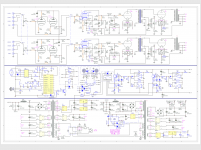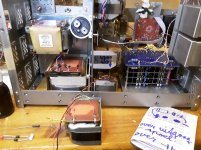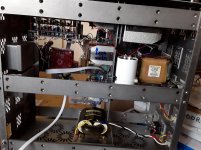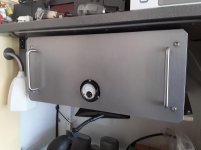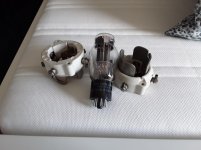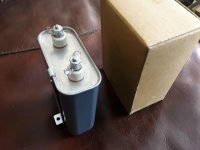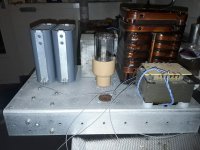the big difference between transformers: one is specially engineered to work without GNF.
my $$ transformers have 1hz to 70khz without any feedback, they are in fact 150 watts each if you use hammond specification. They also have less winding losses, which gives them another great advantage.
The SET from hammond, I highly doubt will sound good without a decent amount of GNF
I am not sure what is your idea of transformer but a transformer that has to work with feedback and get large bandwidth and top performance needs more effort! So it is generally more expensive too.....Heavy compensation to get larger bandwidth is more often a bad palliative.
A poor transformer is a poor transformer regardless of its use. Same is for a good transformer.
what’s the current wisdom on current production tubes? Looks like good prices from psvane and a number of years of credibility behind them. But they have several different versions with prices to match.
The Psvane worldwide main seller is based in Canada and is independent. The tube they sell are a selection. Best production and second choice stuff. No garbage.
As usual with any manufacturer (maybe except those that are really expensive) there always are first choice tubes and second choice, third etc. You have to buy first choice otherwise do not expect much despite the fact you might pay substantial money for lower grades....
This is beautiful (I meant the PX-4, not the PX-300B, in my other post)
45, if Shindo used feedback this way it is to let through transformer distortions, or to cover up for a poor transformer, without cathode feedback I have no clue how this thing could drive anything.
I had 10K loaded and prefered 20K, and maybe 5-10 db of feedback, and the 845 struggled to drive most speakers, it had a louse high 2n harmonic but deep bass, but it had deep bass down the 30s at full power. Except the deep bass, it wasn't sounding tubby on high sensitivity speakers, on others it sounded like a 2$ amplifier.
An externally hosted image should be here but it was not working when we last tested it.
45, if Shindo used feedback this way it is to let through transformer distortions, or to cover up for a poor transformer, without cathode feedback I have no clue how this thing could drive anything.
I had 10K loaded and prefered 20K, and maybe 5-10 db of feedback, and the 845 struggled to drive most speakers, it had a louse high 2n harmonic but deep bass, but it had deep bass down the 30s at full power. Except the deep bass, it wasn't sounding tubby on high sensitivity speakers, on others it sounded like a 2$ amplifier.
Last edited:
45, if Shindo used feedback this way it is to let through transformer distortions, or to cover up for a poor transformer, without cathode feedback I have no clue how this thing could drive anything.
A single ended amplifier will NEVER be able to drive difficult speakers decently regardless of its transformer and amount feedback except in one case: the power demand is ALWAYS a small fraction of its capability. In such special case better results are obtained with better design and components. Is it worth for just a decent result? That's subjective....There is no escape. However there will likely be cheaper solutions that might do better!
You have a good point and understanding of the SET,
I keep in mind the great class D amps too, they are actually what a lot of people are looking for in terms of smoothness...
I auditioned the class D from two companies, one was Project, the turnable designer, and we also compared to the class A accuphase and the capacitor output class A SS from HEED.
All I remember is that the accuphase was more natural and neutral, better, but the class D were very smooth, nothing was harsh, it was just too soft for my taste, but good? yes.
Only later I discovered the Class D from Rotel, driving B&W 802D, it was way better than other companies I will not name here.
So, is the big tubes justified when for a few dollars you can have a mini class D with soft clipping, exceeding other SET amps?
I keep in mind the great class D amps too, they are actually what a lot of people are looking for in terms of smoothness...
I auditioned the class D from two companies, one was Project, the turnable designer, and we also compared to the class A accuphase and the capacitor output class A SS from HEED.
All I remember is that the accuphase was more natural and neutral, better, but the class D were very smooth, nothing was harsh, it was just too soft for my taste, but good? yes.
Only later I discovered the Class D from Rotel, driving B&W 802D, it was way better than other companies I will not name here.
So, is the big tubes justified when for a few dollars you can have a mini class D with soft clipping, exceeding other SET amps?
I don't know much about class D amplifiers. All the Accuphase amps I know are not SE. Class A is not necessarily SE. The smaller models are low power (by solid state standards) and that might be the reason why it didn't sound best. SS amps do not behave as good as tube amps if run at or close to their max power.
Using equipment in the best way is generally better than spending a lot of money without a clue.
Using equipment in the best way is generally better than spending a lot of money without a clue.
Member
Joined 2009
Paid Member
...
So, is the big tubes justified when for a few dollars you can have a mini class D...
this is the big tubes thread
You know 45, the more I think about amps and audio the more I reduce it to this... feedback is a good vacuum cleaner, tubes are good harmonics generators, so you don't want any extremes there, you want to keep it interesting leaving things in the room, but you don't want to room to look like an old grandma house full of flower wall papers, groovy carpets and full of figurines on tables and shelves.
The test is simple, take a good solid state preamp, and the tube gears, add the solid state preamp, if it removes the detail and the sound is getting sterile, the SS amp sucks and the tube is better,
in the opposite case, if the sound is still blooming full of echoes and coloration and there is no difference with or without the SS amp, the SS amp is neutral and the tube is garbage...
This is how I got rid of my 845 amp and my SS power amps. To conduct the elimination tests I had 2 SS amps, 1 tube pre amp 0 feedback, 1 SS amp 0 feedback etc, I was thus able to completely eliminate tube topologies that simply don't work in practice.
I built all the gadgets from Greg, of australia, the SKA, the pre, the regulators, the power regs, the dac boards, the phono etc. and from 2 other tube companies.
And the lesson is, sometimes you have accessible, right there, what you need. There is a reason why they sell kits, and not commercial designs, sometimes, its because it is too badly sounding to place on the shelves of shops, it would not sell.
The test is simple, take a good solid state preamp, and the tube gears, add the solid state preamp, if it removes the detail and the sound is getting sterile, the SS amp sucks and the tube is better,
in the opposite case, if the sound is still blooming full of echoes and coloration and there is no difference with or without the SS amp, the SS amp is neutral and the tube is garbage...
This is how I got rid of my 845 amp and my SS power amps. To conduct the elimination tests I had 2 SS amps, 1 tube pre amp 0 feedback, 1 SS amp 0 feedback etc, I was thus able to completely eliminate tube topologies that simply don't work in practice.
this is the big tubes thread
I built all the gadgets from Greg, of australia, the SKA, the pre, the regulators, the power regs, the dac boards, the phono etc. and from 2 other tube companies.
And the lesson is, sometimes you have accessible, right there, what you need. There is a reason why they sell kits, and not commercial designs, sometimes, its because it is too badly sounding to place on the shelves of shops, it would not sell.
Member
Joined 2009
Paid Member
I built a clone of Greg’s amplifier after he released the design although I made a few tweaks to it and made a modern PCB layout - the result was a very neutral amplifier, perhaps the most neutral amplifier I have yet built. I have a few other solid-state amplifiers And I agree, they are perfectly adequate if not excellent for all of my music needs.
...but this is DIY and there is the fun to build with big tubes...
...but this is DIY and there is the fun to build with big tubes...
Last edited:
Member
Joined 2009
Paid Member
I cannot see, it is too small.
I am actually light years from where I started with Greg stuff.
His SKA sounded neutral... feel free to censor me, sterile, mid-rangy, colored to the extreme, not extended, extremely poor in the bass, where is the bass, none at all, its like if there was a shower of information in the ska sound but unintelligible, and it gave listening fatigue a lot because of the midrange shouting, permanent weird sound-stage.
However, Greg was a super nice person, he helped me all the way through everything, answered every question, about servo, regulators, dacs, all the solid state I could ask him about, he didn't liked tubes.
There are companies with flawed designs which cannot be explained by science alone. It just interacts badly with speakers.
I do not want to get into defamation here and name them, this could be 'subjective' unproven, lot of followers, like sects, however I am positive and can recommend GlassWare, tubes4hifi, for diyers looking for simple circuits which gives a good sound.
The reason for this parenthesis, is that the big power tubes have a sound which can let you down, it is almost the antithesis of the SKA.
I am actually light years from where I started with Greg stuff.
His SKA sounded neutral... feel free to censor me, sterile, mid-rangy, colored to the extreme, not extended, extremely poor in the bass, where is the bass, none at all, its like if there was a shower of information in the ska sound but unintelligible, and it gave listening fatigue a lot because of the midrange shouting, permanent weird sound-stage.
However, Greg was a super nice person, he helped me all the way through everything, answered every question, about servo, regulators, dacs, all the solid state I could ask him about, he didn't liked tubes.
There are companies with flawed designs which cannot be explained by science alone. It just interacts badly with speakers.
I do not want to get into defamation here and name them, this could be 'subjective' unproven, lot of followers, like sects, however I am positive and can recommend GlassWare, tubes4hifi, for diyers looking for simple circuits which gives a good sound.
The reason for this parenthesis, is that the big power tubes have a sound which can let you down, it is almost the antithesis of the SKA.
Last edited:
Member
Joined 2009
Paid Member
If I click the Image until it expands I can see all the parts and part numbers and part values even on my iPad, although I do zoom in when I’m looking at it. uses stacked supplies running the front end at about 400 V and the output at the usual one kilovolt . it uses a 300 B as the driver with interstage transformer to the 845 . The voltage gain stage is a 310 pentode and there are two choices of feedback, one from the interstage transformer, the other from the output transformer, controlled with a simple switch .
SKA: That’s strange I never had those problems with the SKA, although I have only ever built a mono version of it (it also incorporated a couple of tweaks and a completely different printed circuit board which relied on surface mount components), so I can’t comment on the sound stage. if I had any criticism it was in the treble, it seem to lack air, but it was never harsh. I didn’t get much help from Greg after I posted my design improvements to his forum, he deleted my posts showing them. I found the bass performance to be fine but another area of difference may be the power supply.
I don’t know about the sound of big tubes the only one I’ve heard properly is the SV811-10 and it sounded pretty good! but I’ve read a lot of good reviews about amplifiers using the 845 although as we all know the tube alone does not make the sound.
SKA: That’s strange I never had those problems with the SKA, although I have only ever built a mono version of it (it also incorporated a couple of tweaks and a completely different printed circuit board which relied on surface mount components), so I can’t comment on the sound stage. if I had any criticism it was in the treble, it seem to lack air, but it was never harsh. I didn’t get much help from Greg after I posted my design improvements to his forum, he deleted my posts showing them. I found the bass performance to be fine but another area of difference may be the power supply.
I don’t know about the sound of big tubes the only one I’ve heard properly is the SV811-10 and it sounded pretty good! but I’ve read a lot of good reviews about amplifiers using the 845 although as we all know the tube alone does not make the sound.
Last edited:
we all know the tube alone does not make the sound. Hello, So true it is the right mix of elements. I remember buying the Tango X10S output transformer for around 600$ directly in Japan in the eighties.
A major element in the amp is the power supply. I would always use a choke and preferably a choke input. The right capacitors are not that easy to find if you are on a tight budget. BUT i think if you are on a tiny budget you should not choose to build a 211/845 amp. One more concern is the weight of these kind of amps.
The reason the Tango had his height where to big higher than the 211 glas bulb so it could be placed upside down. You could go for some kind of the chassis that could be positioned on most of its sides and still have the tubes on view.
Greetings,
Eduard
A major element in the amp is the power supply. I would always use a choke and preferably a choke input. The right capacitors are not that easy to find if you are on a tight budget. BUT i think if you are on a tiny budget you should not choose to build a 211/845 amp. One more concern is the weight of these kind of amps.
The reason the Tango had his height where to big higher than the 211 glas bulb so it could be placed upside down. You could go for some kind of the chassis that could be positioned on most of its sides and still have the tubes on view.
Greetings,
Eduard
You know 45, the more I think about amps and audio the more I reduce it to this... <snip>
I have a radically different approach. The amplifier is the strong link in any audio system. For most people swapping amps is the easiest thing to do or even the only one. The weakest link is the room, then the source and then the speakers....
There is much more than just colorations (or its opposite) that make the musical sound. But having no control on the room in the first place removes most possibilities....and tone and the usual reviewers parameters are the only left.
Last edited:
Member
Joined 2009
Paid Member
Hello,
For my DRD amp i will go stereo with a big power supply. For my DDDAC had to go stereo too. Made the chassis in a kind '' modular '' approach meaning it can be changed without have to drill extra holes in what is already there. Just change a metal plate into one with a different pattern of holes. The holes to mount it into the chassis will be identical of course.
At this moment it is around 30 kilogrammes. The upcoming modification will involve two big chokes for two little circuits that will be added. Then it will be 40 kilogrammes but happily it will not take it out of the rack every mount because it is above my shoulders. CAN be done after warming up.
Greetings, Eduard
For my DRD amp i will go stereo with a big power supply. For my DDDAC had to go stereo too. Made the chassis in a kind '' modular '' approach meaning it can be changed without have to drill extra holes in what is already there. Just change a metal plate into one with a different pattern of holes. The holes to mount it into the chassis will be identical of course.
At this moment it is around 30 kilogrammes. The upcoming modification will involve two big chokes for two little circuits that will be added. Then it will be 40 kilogrammes but happily it will not take it out of the rack every mount because it is above my shoulders. CAN be done after warming up.
Greetings, Eduard
Attachments
For those not familiar with a Mono Amplifier, I used one of my 845 Mono Block Power Supply and Output modules for about 9 months, while it was a 50% complete project. I used it with a 8 Ohm speaker arrangement, as it was suggested the configuration I was using could possibly cause a failure if the 57's were uses as speakers, as the impedance could easily go down to 1 Ohm. I chose to use a Y phono Adaptor, and share both speaker cables into one Banana Plug, so two speakers could be used.
I referred to this as a faux stereo set up. The separation of instrumentalists was very impressive, I had to consult with the designer / builder to get a clarification on what improvements were to be had when the project was complete,the perception was that the performers were all stacked in line, down the centre line of the sound stage. On one Bob Dylan Track, you could sense the harmonica in front of him.
As a stereo set up, the separation is still very impressive, but it has now moved left and right from the centre line into the wider sound stage. I have not picked up on the type of imaging detail, I perceived with the Bob Dylan Harmonica. There have been some great experiences, surpassing my memories of the SQ in other replays using different amplification.
My Designer/ Builder, does not go for bespoke/boutique components, he works with parts that have proven totally reliable, as he sends works all over the globe. I am interested in exchanging some components, so any brands recommended that could be used on the signal path, would be off interest to me. I am not in a position to quote values at present, as the inside of the Output Modules will probably be a no go area for me. Just some thought on tried and tested parts will suffice at present.
I referred to this as a faux stereo set up. The separation of instrumentalists was very impressive, I had to consult with the designer / builder to get a clarification on what improvements were to be had when the project was complete,the perception was that the performers were all stacked in line, down the centre line of the sound stage. On one Bob Dylan Track, you could sense the harmonica in front of him.
As a stereo set up, the separation is still very impressive, but it has now moved left and right from the centre line into the wider sound stage. I have not picked up on the type of imaging detail, I perceived with the Bob Dylan Harmonica. There have been some great experiences, surpassing my memories of the SQ in other replays using different amplification.
My Designer/ Builder, does not go for bespoke/boutique components, he works with parts that have proven totally reliable, as he sends works all over the globe. I am interested in exchanging some components, so any brands recommended that could be used on the signal path, would be off interest to me. I am not in a position to quote values at present, as the inside of the Output Modules will probably be a no go area for me. Just some thought on tried and tested parts will suffice at present.
since there is so much information in stereo which combines to recreate the room acoustics and air... how can you listen to mono?
1. listen to one channel in one driver. you have an unbalanced sound, you get all the violins or all the bass, you get half the singers... etc
2. you blend channels? it is going to mix up and destroy a lot of the recording some waves will nul out, etc it is going to be a mess.
3. you listen to only mono records... this brings you back down in time and cuts you from our world lol
I tried to listen to one channel tonight, it is ok, weird not to hear everything which is in the other channel, impossible to balance that sound which has some instruments closed, some far.. just weird, and the recorded room acoustic boundaries are now a dead echo which is annoying, like seeing one eye, impossible to judge distances.
1. listen to one channel in one driver. you have an unbalanced sound, you get all the violins or all the bass, you get half the singers... etc
2. you blend channels? it is going to mix up and destroy a lot of the recording some waves will nul out, etc it is going to be a mess.
3. you listen to only mono records... this brings you back down in time and cuts you from our world lol
I tried to listen to one channel tonight, it is ok, weird not to hear everything which is in the other channel, impossible to balance that sound which has some instruments closed, some far.. just weird, and the recorded room acoustic boundaries are now a dead echo which is annoying, like seeing one eye, impossible to judge distances.
Last edited:
Member
Joined 2009
Paid Member
Hello, It is the DDDAC that can be found here with the search engine. It has two Sowter output transformers. One choke input power supply to make around 12 volts dc at around 1A. I changed the input choke which was at first the little one in front to the big one mounted inside. There is another choke input supply to supply a lower voltage at a lower current for the wave IO circuit. Most of the work is already done. If i have to make a changing it will imply just make a new flat piece of metal with some different holes. Which is my daily job. The things that are more time consuming are the things you cannot do yourself. Like the bending and perfect welding!!! Greetings, Eduard
Hello, The point with a 211 amp is that some parts are hard to get nowadays like these. Only see them in my attic. lol
Greetings, Eduard
Hello, The point with a 211 amp is that some parts are hard to get nowadays like these. Only see them in my attic. lol
Greetings, Eduard
Attachments
- Status
- This old topic is closed. If you want to reopen this topic, contact a moderator using the "Report Post" button.
- Home
- Amplifiers
- Tubes / Valves
- The point of an 845, 211, 805 amp?
